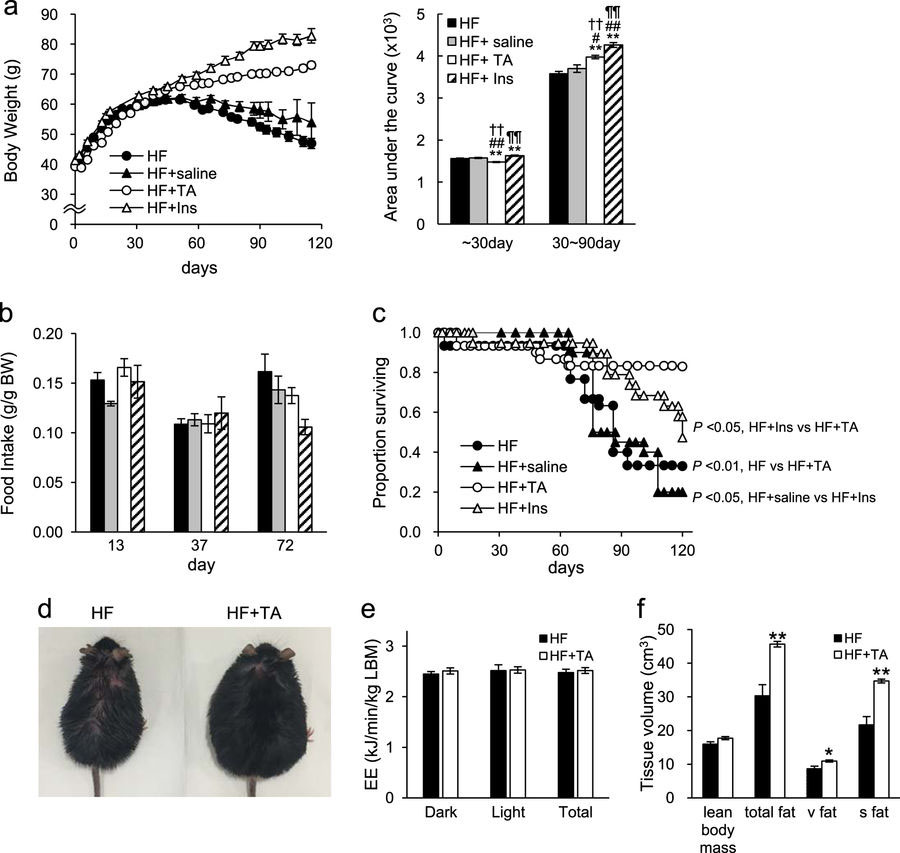糖尿病マウスのSGLT2阻害薬TA-1887による治療は糖尿病性悪液質を緩和して死亡率を低下させる
Treatment of diabetic mice with the SGLT2 inhibitor TA-1887 antagonizes diabetic cachexia and decreases mortality
2017年9月8日 npj Aging 3, Article number:12 (2017) doi:10.1038/s41514-017-0012-0
メタボリックシンドローム:SGLT2iは糖尿病性悪液質を予防して生存期間を延長させる

ナトリウム・グルコース共輸送体2阻害薬(SGLT2i)は糖尿病患者の死亡率に好影響を与えるが、その機序は明らかにされていない。熊本大学の杉崎太一は、重度な糖尿病・肥満マウスでSGLT2iの効果を調べ、それが糖尿病の末期に認められる病的な体重減少や悪液質を生じることなく生存期間の延長を示すことを発見した。その機構として、膵β細胞の機能保護作用、インスリン感受性の改善が認められた。SGLT2i治療群と同様、インスリン治療群にも悪液質の予防、膵β細胞の機能保護作用、生存期間の延長が認められた。しかし、SGLT2i治療群の特徴的所見として、インスリン治療群ではインスリンによる細胞老化や血管の炎症性変化の促進など負の側面が認められたのに対し、SGLT2i治療群ではこれらが認められなかった。このことは、SGLT2i治療がインスリン治療以上に生存期間の延長に寄与したという結果につながると考えられる。SGLT2i治療は、膵β細胞およびインスリン標的器官の機能保護促進により生存期間延長を示し、これらの知見は重度糖尿病の治療戦略に関する新たな洞察をもたらす。
Treatment of diabetic mice with the SGLT2 inhibitor TA-1887 antagonizes diabetic cachexia and decreases mortality
A favorable effect of an inhibitor of the sodium–glucose cotransporter 2 (SGLT2i) on mortality of diabetic patients was recently reported, although mechanisms underlying that effect remained unclear. Here, we examine SGLT2i effects on survival of diabetic mice and assess factors underlying these outcomes. To examine SGLT2i treatment effects in a model of severe diabetes, we fed genetically diabetic db/db mice a high-fat diet and then assessed outcomes including diabetic complications between SGLT2i TA-1887-treated and control mice. We also compare effects of SGLT2i TA-1887 with those of lowering blood glucose levels via insulin treatment. Untreated db/db mice showed remarkable weight loss, or cachexia, while TA-1887-treated mice did not but rather continued to gain weight at later time points and decreased mortality. TA-1887 treatment prevented pancreatic beta cell death, enhanced preservation of beta cell mass and endogenous insulin secretion, and increased insulin sensitivity. Moreover, TA-1887 treatment attenuated inflammation, oxidative stress, and cellular senescence, especially in visceral white adipose tissue, and antagonized endothelial dysfunction. Insulin treatment of db/db mice also prevented weight loss and antagonized inflammation and oxidative stress. However, insulin treatment had less potent effects on survival and prevention of cellular senescence and endothelial dysfunction than did TA-1887 treatment. SGLT2i treatment prevents diabetic cachexia and death by preserving function of beta cells and insulin target organs and attenuating complications. SGLT2i treatment may be a promising therapeutic strategy for type 2 diabetes patients with morbid obesity and severe insulin resistance.

